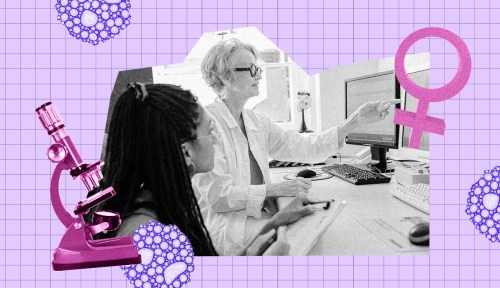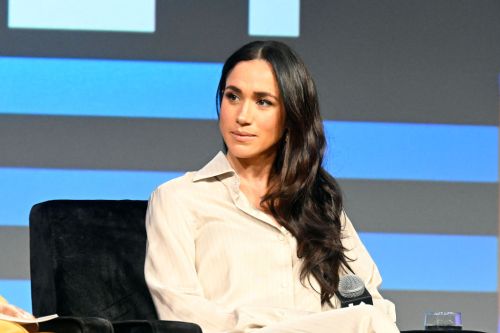Three men walk into an emergency room. So do three women. Who’s getting the best care?
Experts in This Article
CEO and founder of Women’s Health Access Matters
president and CEO of the Society for Women’s Health Research
associate director of the Connors Center for Women’s Health &
senior director of government and political affairs for The American College of Obstetricians and Gynecologists
All kinds of factors could come into play here (insurance, socioeconomic status, race, which patient is most emergent). But in general, doctors will often automatically know with more certainty how to treat someone who was assigned male at birth.
Despite the setup, this isn’t a joke. Rather, it’s a harsh reality caused by a lack of representation in health research that reaches back decades, even centuries, says Primavera Spagnolo, MD, PhD, associate director of the Connors Center for Women’s Health & Gender Biology at the Brigham and Women’s Hospital and assistant professor of psychiatry at Harvard Medical School.
Women and folks assigned female at birth are under-studied in medical research, including in human clinical trials and even in research on lab mice—female rodents weren’t mandated to be included in research by the National Institutes of Health (NIH) until 2016. For this reason, there’s a gap in our understanding when it comes to how certain conditions manifest in women and how treatments affect them.
Case in point: Women are more likely to have depression, PTSD, and autoimmune diseases, and they’re nearly twice as likely to develop Alzheimer’s disease. But clinical trials testing medications for these conditions have been mainly conducted in men, creating a dramatic lack of knowledge that has repercussions for both our health and economy, per the nonprofit Women’s Health Access Matters (WHAM).
“In medical schools, we are rarely taught about sex differences and sex-specific factors that influence the prevalence of a disease or the treatment response,” Dr. Spagnolo says.“Nobody is showing us how to look for sex differences with the same condition. There’s just a lack of knowledge.”
Similarly, she says, looking for sex differences is often an afterthought in clinical research. “Clinicians and scientists often learn the importance of considering sex and gender in health on their own,” she reveals.
That’s not to say that sex differences come into play in every single medical situation (nor that the medical community is completely clueless when it comes to diagnosing and treating women). But treating all adults based on research primarily done in men can lead to poor outcomes for those who don’t fit the model. “I would say in 90 percent of the cases, we don’t harm women, but we don’t give them the best, most tailored treatment possible,” Dr. Spagnolo says. But the other 10 percent of cases can be life or death.
For example, heart attacks sometimes show up differently in men than they do in women, but most doctors are predominantly taught about the signs in men, says Dr. Spagnolo. So a man who comes into the ER with chest pain may be treated more quickly than a woman who comes in with shoulder pain and nausea.
Overall, this lack of knowledge can lead to harm for those three women heading into the ER—and all of us. “In medicine, not knowing is never something that helps,” Dr. Spagnolo says.
This is why President Joe Biden recently signed an executive order to help expand women’s health research, adding funding, improving data collection, and focusing on under-studied conditions that affect women, such as menopause and maternal health.
But when we’re this far behind, how much can it help? Here, we turned to experts for what you should know about this order and got their tips on how to best advocate for yourself medically in a world that has under-prioritized the health of half the population for far too long.
First, some history
The lack of adequate women’s health research has come from decades (if not centuries) of mistakenly assuming that women were “just smaller versions of men,” says Carolee Lee, CEO and founder of WHAM. And for years, the way drugs were tested and patients were treated followed that logic.
What’s more, some events led to women being underrepresented in clinical trials on purpose, such as the thalidomide tragedy in the 1950s and 60s, when pregnant women were prescribed an anti-nausea medication that was later linked to severe birth defects in thousands of babies. Similarly, the synthetic hormone diethylstilbestrol (DES), which was prescribed to many pregnant people from 1938 to 1971 to prevent miscarriage and other complications, was found to elevate cancer risk to both the people who took DES, and their children who were exposed to it in the womb.
“In response to these tragic events, the FDA issued guidelines banning most women of ‘childbearing potential’ from participating in clinical research studies,” Dr. Spagnolo says. “The focus at that time was to protect the most vulnerable populations, but the result was that most women were banned until 1993.”
The fact that women menstruate has also been a historic reason to exclude them from studies, Lee says, because fluctuating hormone levels could “complicate the science.”
“There was just this idea that only including men would simplify the process of a clinical trial,” Dr. Spagnolo adds. “Whatever we discovered in men would just apply also to women. Now we know that’s not always true, and we have to make up for all these years in which women weren’t adequately enrolled in clinical trials.”
That’s not to say things haven’t improved somewhat over time. In 1997, the FDA put out rules requiring manufacturers to show their drugs were safe based on age, sex, and race. A 2016 check-in found that women finally accounted for about half of participants in clinical trials funded by the NIH.
But, Dr. Spagnolo warns, as much as things have gotten better, there’s still a lot of data and research loss to make up for. That’s where Biden’s plan comes in.
“I hope that in the next 10 or 20 years, we won’t need any executive order. We’ll have research spontaneously and intentionally looking for sex differences and finding innovative solutions for female-specific conditions. But we need to acknowledge that this mindset is not there yet.” —Primavera Spagnolo, MD, PhD, research scientist
Will Biden’s executive order help?
Biden’s new order plans to tackle the sex discrepancies in research in a few major ways:
- Adds $200 million for the NIH to fund women’s health research (in addition to $100 million already announced)
- Strengthens data standards when it comes to research on and funding for women’s health
- Directs agencies to prioritize funding women’s health research, and to assess gaps in this funding now that may be remedied
- Builds on Biden’s ask of Congress to invest $12 billion in new funding for women’s health research at the NIH
- Increases research and proposals on menopause, environmental factors, and technology as it relates to women’s health
Now, it’s important to note, one big piece of this is tentative: “The $12 billion needs to be passed by Congress,” notes Kathryn G. Schubert, president and CEO of the Society for Women’s Health Research. “The work really begins now to see what we can do as an advocacy community to try to get as much funding as possible allocated by Congress, which is not a process we have much control over.” If Biden doesn’t win re-election later this year, the money he put toward this cause won’t automatically be taken away, but general progress and prioritization may dissipate.
Despite these caveats, the response from researchers, doctors, and organizers in this space has been positive. Lee says she’s glad to see the executive order raising awareness that this is an issue at all, as so many of us don’t realize the disparities we face every day. “There’s so much data that shows that women are disproportionately or differentially affected by disease,” Lee says. “Why do women not get upset with this or want to do something about it?”
The main answer is, we’re not always fully aware of these disparities and how personally affected we may be. Recognizing this on a collective level and working to resolve these disparities could be the difference in getting a doctor who believes your pain, or recognizes your mom’s heart attack symptoms, or treats your daughter’s endometriosis appropriately. But admitting the problem is the first step, Lee says. And that’s part of what advocates love about this executive order.
“This recognition, coming from the highest levels of government, sends a powerful message,” says Rachel Tetlow, The American College of Obstetricians and Gynecologists (ACOG)’s senior director of government and political affairs. “ACOG has long advocated for increased investment across administrations and Congresses, and we look forward to the advancements in clinical research, public health, and most importantly, to the improvements in patient outcomes this investment will bring.”
Some conservatives have criticized the order—often pointing to the fact that women, on average, have a longer life expectancy than men—but Lee emphasizes this isn’t just about life and death, but quality of life and being treated appropriately (and knowing how to treat an issue at all) when there’s a problem. Dr. Spagnolo emphasizes that the order is simply about equity. “No one is advocating that women become the majority of representation in clinical trials,” Dr. Spagnolo says. “Improving the inclusion of women—particularly women of different racial and ethnic backgrounds—in clinical trials is about having better health for everyone. And it is a fundamental step to achieve health equity.”
She adds: “I hope that in the next 10 or 20 years, we won’t need any executive order. We’ll have research spontaneously and intentionally looking for sex differences and finding innovative solutions for female-specific conditions. But we need to acknowledge that this mindset is not there yet.”
How to advocate for your health while research on women is still lacking
Inequities in health research have everyday consequences, leaving many people feeling unheard, living with misdiagnoses, or worse. But as you navigate a world full of these knowledge gaps, there are some ways to advocate for yourself, Schubert says.
First things first: “If you feel you’re being dismissed, you have the right to change health care providers,” Schubert says. This, of course, is easier said than done. If your insurance isn’t great or your financial situation isn’t ideal, it can be more difficult to make the jump. But Schubert says that if you’re not feeling listened to or you think your treatment isn’t helping, it’s worth flagging and making some calls.
Start by phoning your insurance provider and ask for a list of physicians who are covered, then call those physicians to ensure they still take your insurance. It can feel like a headache, but it’s worth it so you don’t get stuck with a big bill.
If you feel more comfortable with a provider who’s of the same gender identity or race as you, make a point to find this person.
Schubert also recommends preparing for health appointments, and being assertive if you need to be when getting your questions answered. Track your symptoms in a note on your phone, and mention them to your provider. Write down any questions you want to ask ahead of time, so you don’t get distracted or forget. “Having that information in writing can really help you stay on track and get to the bottom of whatever is going on,” she says.
If your doctor has to dash off, try asking a nurse. If your provider uses an app where you can message them and book appointments, feel free to shoot them a message afterward if you do forget something. You can also consider bringing your partner, a friend, or any other loved one along to health appointments to act as your health advocate, helping ask questions and offer support.
Yes, unfortunately, this means a lot of the onus is on you. It shouldn’t have to be, Schubert says. But as science catches up, it’s worth it to make sure you’re doing everything to get the best care you can.
In the meantime, you can also call your Congress representatives and ask them to support women’s health research.
“I am confident that one of the effects of this executive order will be to transform the way we do science and deliver care,” Dr. Spagnolo says. “I am confident that in the next 10 years, we will begin observing the results of these transformative changes, with the inclusion of factors like sex, gender, race, and ethnicity in medicine and science being the norm.”
This story was updated on April 8
—reviewed by Jennifer Gilbert, MD, MPH
Sign Up for Our Daily Newsletter
Get all the latest in wellness, trends, food, fitness, beauty, and more delivered right to your inbox.
Got it, you've been added to our email list.










